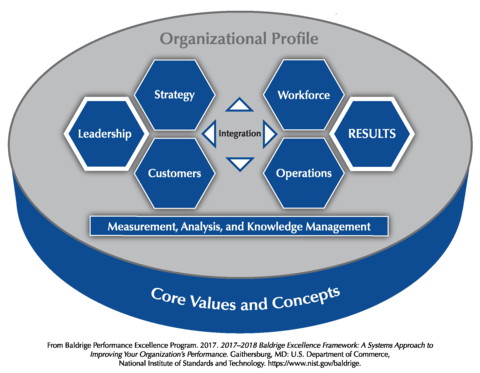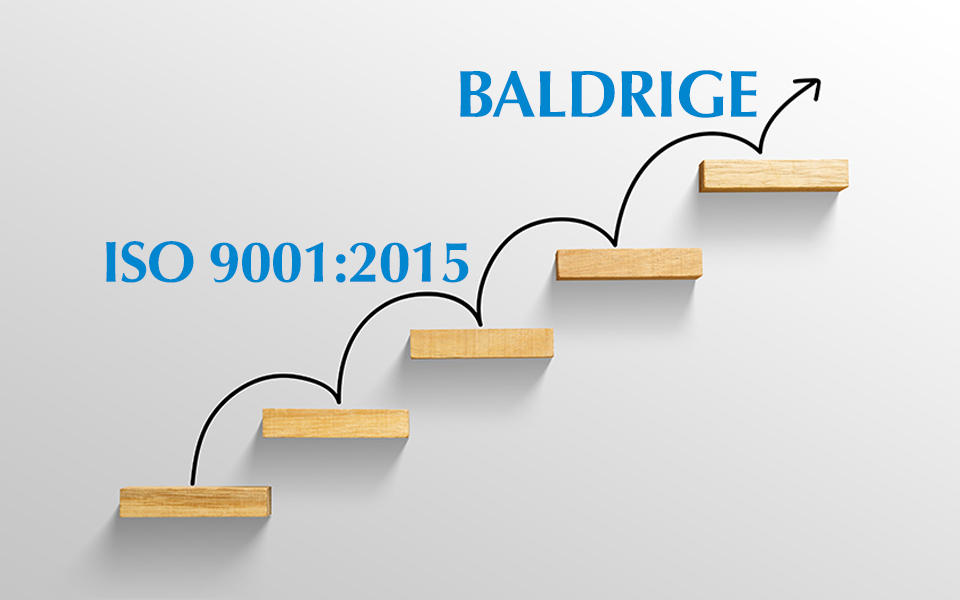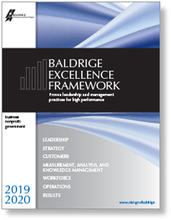Blogrige
The Official Baldrige Blog
Is Good, Good Enough for You? Taking the Next Step After ISO 9001:2015

Winter 2018-2019
A recent report entitled Risk-Based Thinking: Creating Opportunities from Strategic Insights by Nicole Radziwill includes references to both the Baldrige Excellence Framework and ISO 9001:2015. The report describes the role of risk-based thinking in ISO 9001:2015. Since risk is based on the systems being impacted, the report recommends starting with an organizational profile, called the organizational context in ISO 9001:2015. In the Baldrige Excellence Framework, the Organizational Profile is “category 0” of the Criteria for Performance Excellence and sets the background (quite literally, as you can see in the framework diagram below) against which all other Baldrige Criteria questions are answered.

Reading the report by Radziwill reminded me that beyond the organizational context, there have been other significant changes in ISO 9001 over time that have increased the “kinship” between ISO 9001 as a conformity assessment model and the Baldrige Criteria as a performance excellence framework.
Below I will describe the similarities and the differences between ISO 9001:2015 and the Baldrige Criteria, and I will conclude with the elements unique to the Baldrige Excellence Framework that are not part of conformity assessment in ISO 9001. I will address the first two topics in the order they are presented in ISO 9001:2015. While my analysis is not exhaustive, I hope it will give you a good sense of the compatibility of the two documents and why your organization, having achieved ISO 9001:2015 certification, will benefit from striving for performance excellence using the Baldrige framework.
The Similarities Between ISO 9001:2015 and Baldrige
Both ISO 9001 (as stated in the introduction to the ISO 9001 standard) and Baldrige are focused on the delivery of quality products and services that are acceptable to customers and that meet legal and regulatory requirements. Both documents require a process approach to address their content. Both approaches use quality management principles, stated in the ISO 9001:2015 standard as follows: customer focus (category 3 in Baldrige); leadership (category 1 in Baldrige); engagement of people (category 5 in Baldrige); process approach (category 6 in Baldrige); improvement (Scoring Guidelines and elsewhere in the Baldrige Criteria); evidence-based decision making (category 4 in Baldrige); and relationship management (the Organizational Profile, as well as categories 1, 3, and 5 in Baldrige).
RESULTS
Both approaches have a commitment to results (see Figure 2 in the ISO 9001 standard and category 7 in the Baldrige Criteria). Both approaches use risk-based thinking to improve results and prevent negative effects.
INTRODUCTION AND DEFINITIONS
Clauses 1 through 3 of ISO 9001:2015 provide introductory information and a reference to definitions given in ISO 9000:2015. The Baldrige framework provides similar introductory information and its own Glossary of Key Terms.
ORGANIZATIONAL CONTEXT AND PROCESSES
Clause 4—and 4.1 of ISO 9001, in particular—is about understanding the context of the organization, including both internal and external issues that are relevant to its current state and strategic direction. The Baldrige Organizational Profile consists of a description of organizational characteristics and the organization’s strategic situation. Clause 4.2 of ISO 9001 requires the identification of interested parties and their requirements. The Baldrige Organizational Profile asks about the requirements and expectations of customers and other key stakeholders, suppliers, partners, and collaborators. Clause 4.4 of ISO 9001 addresses management of organizational processes and use of measurements and performance indicators to control processes. Category 6 of the Baldrige Criteria addresses work processes and operational effectiveness. Item 4.1 (within category 4) of Baldrige addresses measurement, analysis, and improvement of organizational performance.
LEADERS' ROLES
Clause 5.1 of ISO 9001 is Leadership and Commitment. It addresses the leadership’s role with respect to the quality management system and requires compatibility with the organizational context and strategic direction. It includes a responsibility for “engaging, directing and supporting” the people of the organization.The Baldrige Criteria’s category 1 addresses the role of leaders, including senior leaders’ roles in creating “an environment for success now and in the future” and communicating with and engaging the entire workforce.
CUSTOMER FOCUS
Clause 5.1.2 of ISO 9001 requires leadership commitment to a customer focus and enhancing customer satisfaction. Item 1.1 (within category 1) of Baldrige asks how senior leaders communicate with and engage key customers. Category 3 addresses listening to the customer and engaging with customers.
PLANNING
Clause 6 of ISO 9001 relates to quality management system planning. Strategy, which is category 2 of the Baldrige Criteria, relates to all aspects of organizational planning.
ORGANIZATIONAL RESOURCES
Clause 7.1 of ISO 9001 is Resources. It instructs organizations to consider what they obtain from external providers, how they provide the people necessary for effective organizational process performance, and how they provide and maintain a suitable infrastructure, the human and physical environment. 7.1.6, Organizational Knowledge, requires that organizational knowledge be maintained and be made available. Those Clause 7.1 topics are covered in Baldrige categories 5 and 6, Workforce and Operations, respectively. Organizational knowledge is covered in Baldrige item 4.2, Information and Knowledge Management (within category 4).
Clause 7.2 of ISO 9001 is Competence. It requires the organization to maintain a workforce that is competent to carry out the work of the organization. Baldrige addresses this topic in item 5.1, Workforce Environment (within category 5), asking about workforce capability and capacity. Having capability and capacity ensures that the workforce is competent to carry out the work of the organization and that there are sufficient staff members available.
OPERATIONS
Clause 8 of ISO 9001 is Operations and has significant overlap with Baldrige category 6, also entitled Operations.
CUSTOMER COMMUNICATION
In Clause 8.2.1, ISO addresses Customer Communication. Baldrige addresses this in the overall focus on customers, which is the subject of category 3.
PERFORMANCE EVALUATION
Clause 9 of ISO 9001 is Performance Evaluation. It requires evaluation of operational performance and customer satisfaction. It also has a specific clause, 9.3, on management review of the quality management system. Baldrige Criteria item 4.1b is Performance Analysis and Review (within category 4). Baldrige has a separate area to address, 3.2b, on Determination of Customer Satisfaction and Engagement (within category 3). In Baldrige Criteria item 1.1, Senior Leadership (within category 1), there is a responsibility to create a focus on action based on identifying needed actions to improve organizational performance. Leaders must demonstrate personal accountability for those actions.
IMPROVEMENT
Clause 10 of ISO 9001, Improvement, addresses nonconformity, corrective action, and continual improvement. It states that improvement can include innovation. The Baldrige Criteria ask specifically about product and process improvement in 6.1b(3). Within category 4, 4.1c focuses on future performance, looking at use of performance review findings as a source of continuous improvement and opportunities for innovation. The Baldrige Scoring System is a rubric for organizational maturity in performance improvement.

The Differences Between ISO 9001:2015 and Baldrige
Now let’s focus on some key differences between ISO 9001:2015 and the Baldrige Criteria that can move an organization from conformity to striving for excellence. To begin, it is important to remember that the two documents are written with significantly different purposes in mind.
ISO 9001: 2015 is a standard for “consistently providing products and services that meet customer and applicable statutory and regulatory requirements, facilitating opportunities to enhance customer satisfaction,” and “addressing risks and opportunities.” This is all done in the context of delivering a product or service in conformance with quality management system requirements.
In contrast, the Baldrige Excellence Framework is designed to help all organizations improve and get ever-improving results. The Baldrige framework helps any organization answer three questions:
- Is your organization doing as well as it could?
- How do you know?
- What and how should your organization improve or change?
The end goal is organizational excellence, which is recognized in the United States by a Presidential Award (the Malcolm Baldrige National Quality Award) that designates the organization as a role model for the nation (and beyond).
While the purposes of ISO 9001 and Baldrige are different, it is particularly valuable that the two approaches to organizational performance are so compatible, allowing a smooth transition from conformity assessment and certification to overall organizational performance assessment and a continuing journey to performance excellence.
Focus on Transition from Conformance to Excellence
Now let’s focus on aspects of the Baldrige Criteria that move an organization from requirements that address conformity to questions that address the journey toward excellence. I will address each of the clauses of ISO 9001:2015 in the order covered above, starting with some additional comments relative to the introductory material in both documents (the Introduction and Clauses 1—3 of ISO 9001:2015).
A Focus on INNOVATION
ISO 9001:2015 requires corrective actions and continual improvement to “consistently meet requirements and address future needs and expectations.” It states that future needs might require breakthrough change and innovation. Baldrige adds a specific focus on innovation, at numerous places in the Criteria. The multiple references emphasize the systems perspective for organizational performance innovation. Item 1.1 (within category 1) asks how senior leaders create an environment for innovation and intelligent risk taking (more on risk in the next section). Within category 6, 6.1d asks about work processes for innovation management, specifically how you pursue opportunities for innovation. The Baldrige Scoring Guidelines (the scoring rubric for a Baldrige assessment) specifically reference organizational learning through innovation in the highest scoring ranges.
A Focus on CUSTOMER ENGAGEMENT
ISO 9001 promotes a process approach “to enhance customer satisfaction by meeting customer requirements.” While Baldrige asks questions about customer satisfaction and dissatisfaction, it is focused on customer engagement for the long term, to build a relationship with the customer, exceed customers’ expectations, and increase their engagement with your organization over time (category 3).
A Focus on STRATEGIC CONTEXT
Clause 4 of ISO 9001 and the Organizational Profile of the Baldrige Criteria both look at organizational context. Baldrige specifically asks about the organization’s mission, vision, and values, as well as the organization’s core competencies (not just those required of individual staff members). These concepts are strategic and form the basis, together with articulated strategic advantages and strategic challenges, for overall organizational strategic planning. Baldrige also asks about changes affecting your competitive position and how these changes might create opportunities for innovation and collaboration.
A Focus on the HOLISTIC ROLE OF SENIOR LEADERS
Clause 5.1 of ISO 9001 is about organizational leadership. The Baldrige Criteria item 1.1, Senior Leadership, adds the senior leaders’ role in setting and deploying the organization’s vision and values throughout the organization and to key stakeholders. These values are critical guides for norms of behavior and setting organizational culture. Senior leaders are also questioned about their roles in organizational and employee personal learning and leadership succession planning, including development of future organizational leaders. Thus, in the Baldrige Criteria, senior leaders are responsible not only for guiding the organization today, but for creating the environment for success in the future.
A Focus on ORGANIZATIONAL STRATEGY
Clause 6 of ISO 9001 addresses Quality Objectives and Planning to Achieve Them. The Baldrige Criteria category 2, Strategy, addresses strategy broadly. Quality planning can be delegated to a quality function in the organization. Strategic planning starts with the senior leadership and cascades throughout the organization, including the quality planning function. Category 2 asks about the specifics of the strategy development process, your key strategic objectives, how your strategy development process stimulates innovation, and also about your work systems and core competencies. Work systems are a key strategic concept.
In determining your work systems and related core competencies, the organization is deciding what will be accomplished with your workforce, using competencies core to the organization’s success; and what will be accomplished through suppliers, partners, and collaborators. This decision involves important considerations related to protecting intellectual property and brand, as well as the actual footprint of your operations. The Baldrige Criteria also ask about your translation of strategic objectives into action plans and workforce plans and measures to track progress on action plans. Additionally, Baldrige asks about your process for being agile, should conditions warrant a rapid change in plans.
A Focus on the WORKFORCE
As Clause 7.1 of ISO 9001 indicates there are numerous aspects to resources. People aspects are treated in 7.1.2 and 7.1.4. People and Environment for the Operation of Processes, respectively. Category 5 in the Baldrige Criteria, Workforce, views people as both a valuable resource and as the internal customers of the organization, recognizing that an engaged workforce leads to a more successful organization. Given this understanding, Baldrige asks about drivers of workforce engagement and how your organization supports its workforce through benefits, compensation, reward, and recognition. Baldrige also asks about how you accomplish workforce development, learning, and career progression, as well as how you ensure workplace health, safety, and accessibility.
A Focus on ORGANIZATIONAL LEARNING
Clause 7.1.6 of ISO 9001 is about capturing organizational knowledge for the purpose of “operation of its processes and to achieve conformity of products and services.” Within category 4, the Baldrige Criteria item 4.2 is Information and Knowledge Management. It additionally asks about blending and correlating data from different sources to build new knowledge. It asks about mining and sharing best practices throughout the organization, and it asks how you embed learning in the way your organization operates.
A Focus on CUSTOMER COMMUNICATION TO BUILD LONG-TERM COMMITMENT
Clause 8.2.1 of ISO 9001 is Customer Communication. Within the Baldrige Criteria category 3, 3.1a, Customer Listening, asks how your organization listens to potential customers to obtain actionable information. Also within category 3, Baldrige asks at 3.2b, Determination of Customer Satisfaction and Engagement, how you determine your customers’ satisfaction with your organization relative to competitors and other organizations.
A Focus on ALL ASPECTS OF ORGANIZATIONAL PERFORMANCE EVALUATION
Clause 9 of ISO 9001 is Performance Evaluation, covering all aspects of the quality management system. Within category 4, item 4.1 in the Baldrige Criteria is Measurement, Analysis, and Improvement of Organizational Performance. The Baldrige focus is on all aspects of organizational performance, including the quality system. Baldrige also asks how you use comparative data to support decision making. It asks how you assess organizational success, competitive performance, financial health, and progress on achieving your strategic objectives and action plans.
A Focus on the EVER-IMPROVING ORGANIZATION
Clause 10 of ISO 9001 is Improvement. The Baldrige Scoring System allows assessment of organizational performance maturity on a 1,000-point scale There are separate rubrics for Baldrige assessment of process and results. Process is assessed on organizational improvements in approach (the method used to carry out a process), deployment (the extent to which your organization applies the approach), learning (the refinement of your approach through cycles of improvement and through innovation), and integration (the extent of harmonization of your approach, plans, results, and analyses across processes and work units). Results are assessed on organizational improvement in the dimensions of levels (current performance), trends (rate of performance improvement), comparisons (performance relative to other appropriate organizations), and integration.
Elements Unique to Baldrige
Numerous areas associated with overall organizational excellence that are not part of product and process conformity are, nonetheless, critical to overall organizational performance and to achieving performance excellence. Following is a brief description of each of these areas covered in the Baldrige Excellence Framework:
- Ethics: How your organization and its leaders demonstrate and monitor ethical performance and ensure transparency in operations.
- Governance: How your organization achieves responsible governance through oversight of senior leaders’ performance and operations.
- Societal Contributions: Beyond legal compliance, how your organization supports and strengthens communities served.
- Security and Cybersecurity: How your organization ensures the security and cybersecurity of sensitive or privileged data and information.
- Risk: Since organizations can no longer avoid risk, risk management has been significantly incorporated into ISO 9001:2015. Risk is also addressed by the Baldrige Criteria, from the perspective of taking intelligent risks. Intelligent risks are seen as opportunities for which the potential gain outweighs the potential harm or loss to your organization’s future success if you do not explore them. Risk is frequently viewed from only the harm perspective, but Baldrige also sees intelligent risk as arising from opportunities for innovation.
- Results: In addition to your organization’s performance results in the areas of product and process performance and customers (as needed to demonstrate conformity for ISO 9001:2015), Baldrige assesses workforce results, leadership and governance results, and financial and market results.
Encouragement
I have not shared all the commonalities of or differences between ISO 9001:2015 and the Baldrige Excellence Framework. Instead, I have tried to show the organizational possibilities of building on conformity assessment to establish a holistic approach for achieving excellence in every dimension of organizational performance today, with a look to the strategic imperatives and opportunities for the future. Baldrige helps an organization take this journey with a focus on process (55% of the scoring rubric) and results (45% of the rubric), recognizing that great processes are only valuable if they yield the complete set of results that lead to organizational sustainability.
I encourage organizations that have not gone beyond conformity to take the next step in securing your future. Start with downloading the free Baldrige Excellence Builder, an abbreviated version of the Baldrige Criteria for Performance Excellence. I hope that your organization, like many others, will look back in future years wondering why you didn't start the journey to excellence earlier!
Resources
PC = PM + P²D (Summer 2018)
Love Was in the Air (and Financial Reserves Are in the Wallet) (Spring 2018)
Archived Columns
A Systems Approach to Improving Your Organization’s Performance

Baldrige Excellence Framework
The Baldrige Excellence Framework has empowered organizations to accomplish their missions, improve results, and become more competitive. It includes the Criteria for Performance Excellence, core values and concepts, and guidelines for evaluating your processes and results.
Purchase your copy today!
Available versions: Business/Nonprofit, Education, and Health Care






Well written article. It connects Compliance to Excellence. Organizations must strive for the Inclusive growth & Sustenance rather focusing on short-term goals.